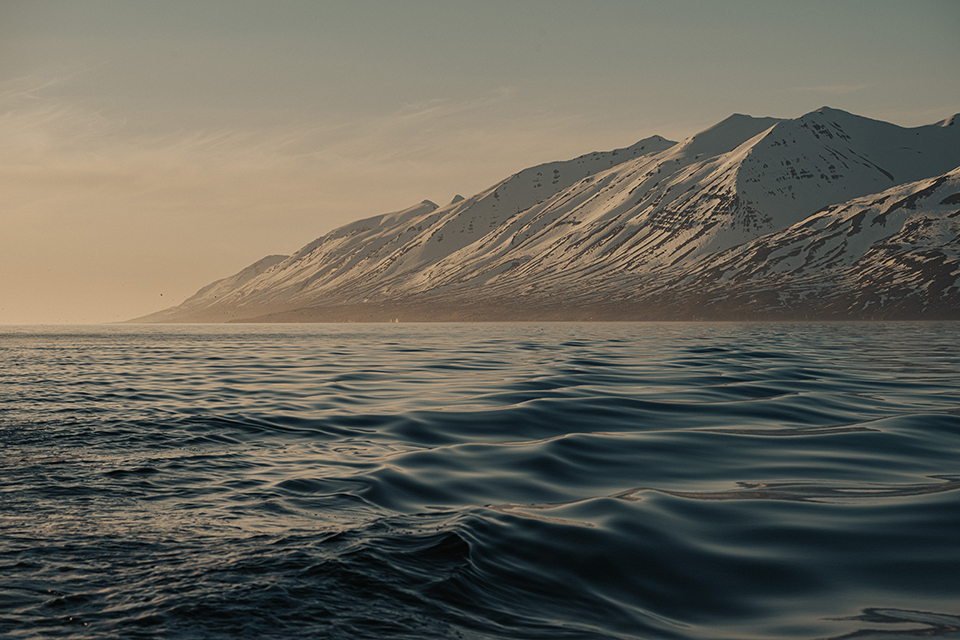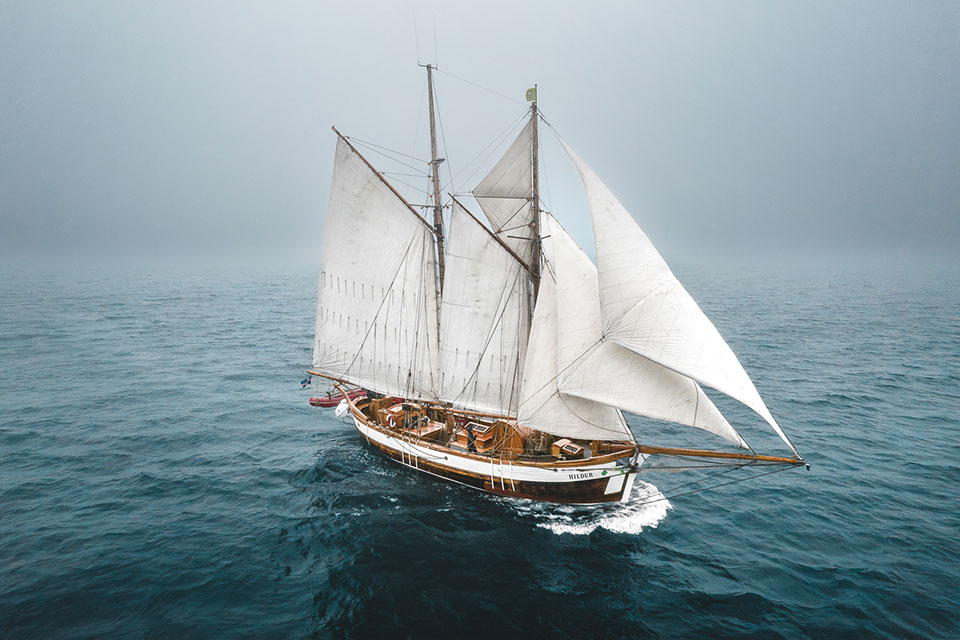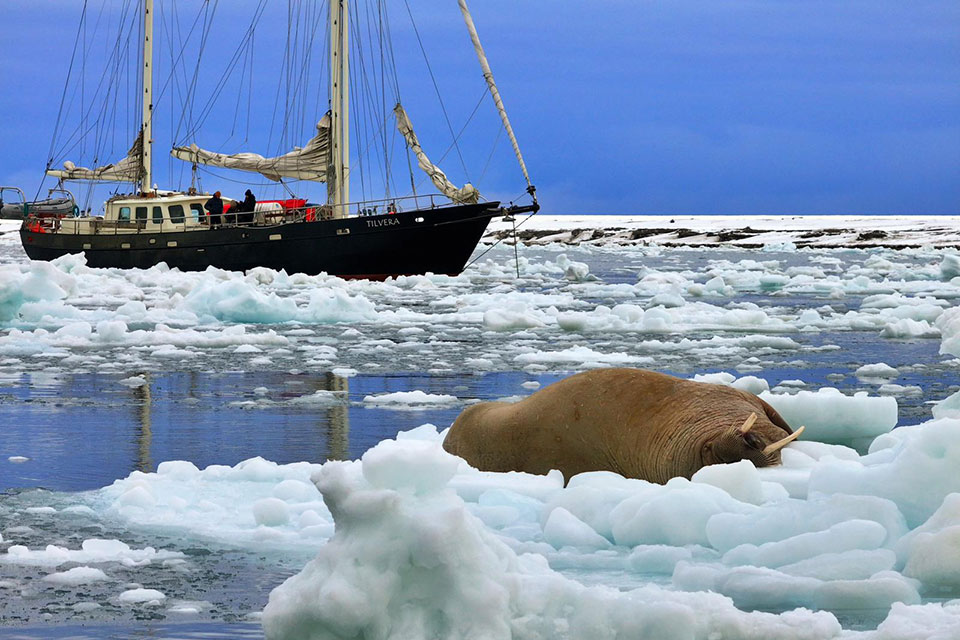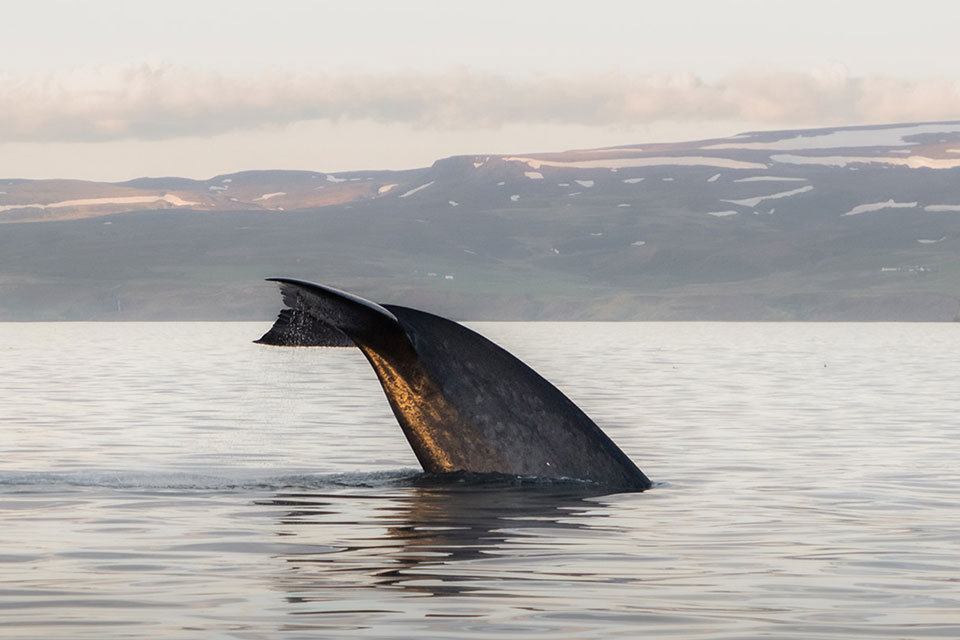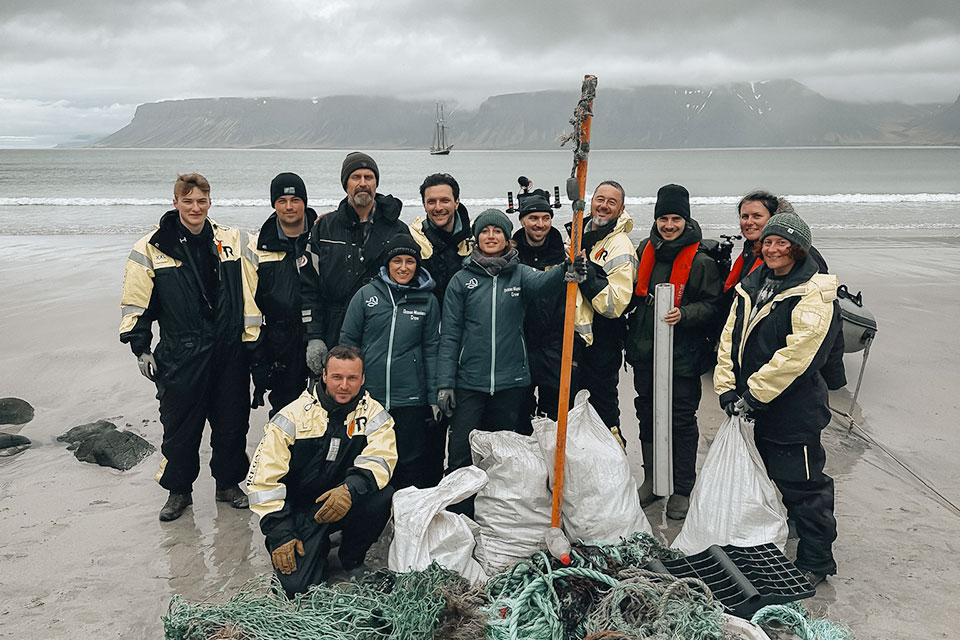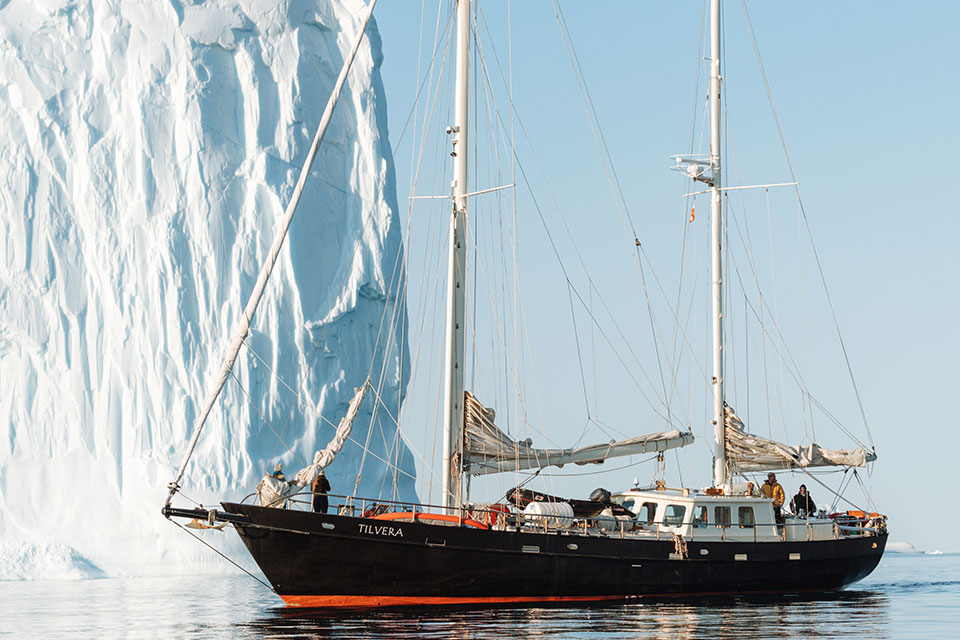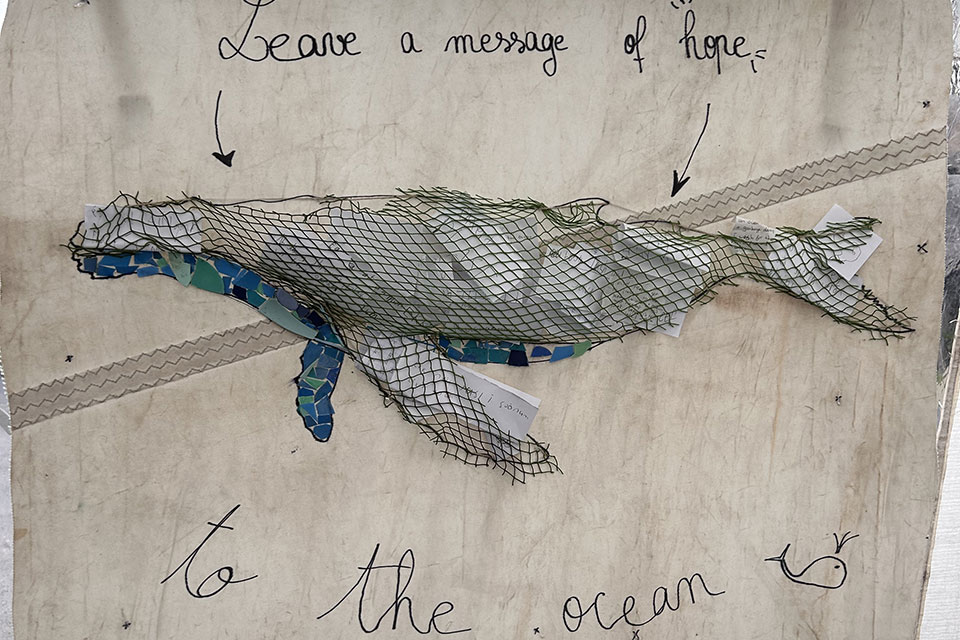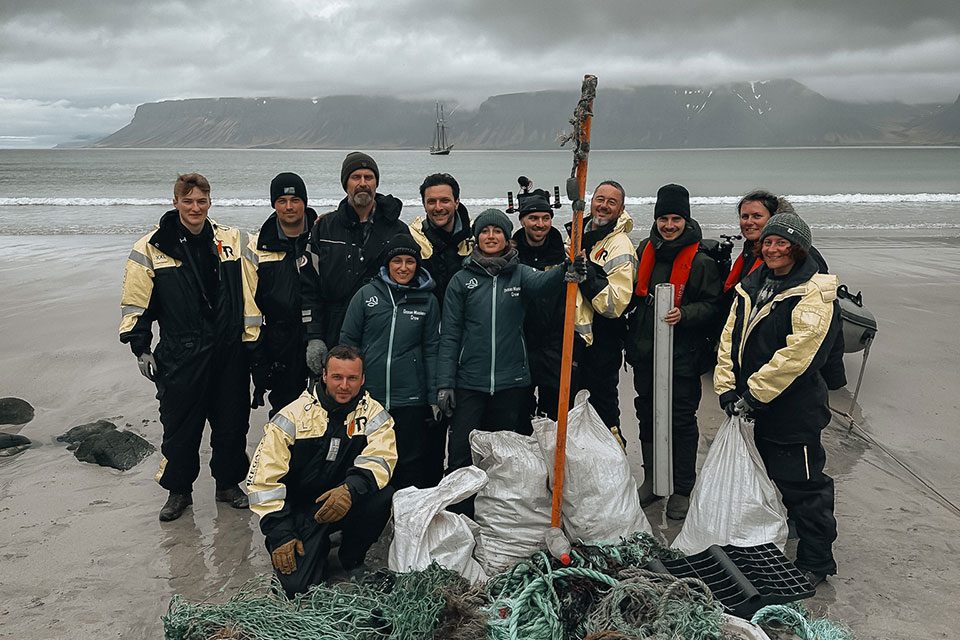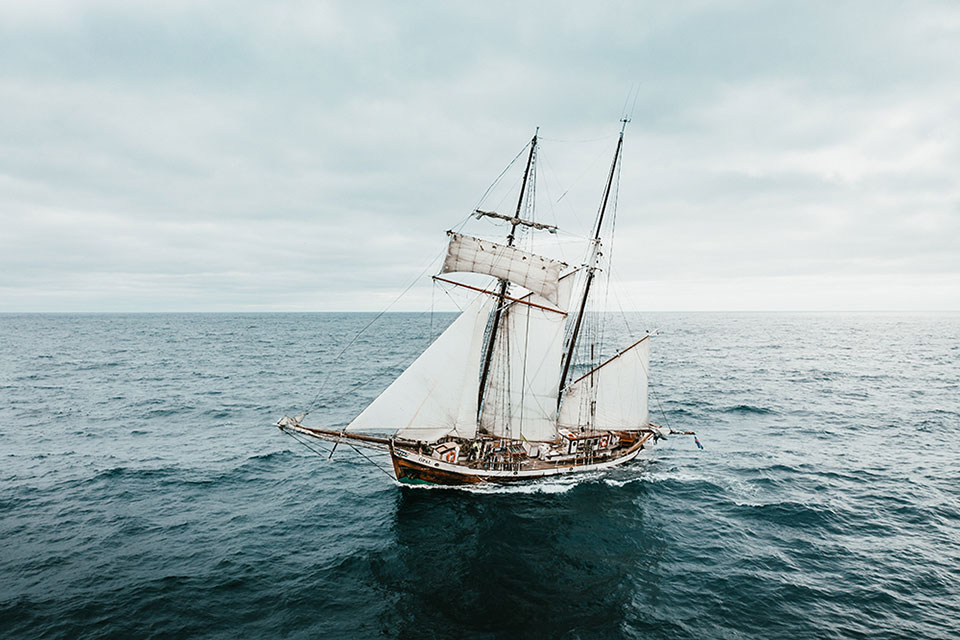To Move. To Discover. To Connect.
Three verbs that touch the soul of the adventurer, the traveller, the dreamer, and that always lead him – or her – to look beyond the horizon.
Becoming champions of Iceland’s First Hope Spot, the Northeast Iceland Hope Spot, the achievement that lit up our 2023, has also inflated the sails of our 2024, leading us to look further ahead. And upwards – quite literally.
Belén had the wonderful impulse to continue connecting, this time not only with people but also with the land and the ocean itself, on another level: Why not create a link between our newly declared Hope Spot and another of the wildest, most isolated and vital Hope Spots in the North Atlantic?
That was the question that gave birth to the Hope Expedition Svalbard.
In keeping with innovation and dreams fulfilled, this time we would not use our usual homebase, Ópal, to carry out the expedition, but would travel instead aboard Tilvera, Belén and Heimir’s beautiful, agile, vigorous and newly acquired ship.
On my end, being able to participate in this trip opened up a whole world of possibilities. I soon realised that I knew people who could also fall in love with the idea of travelling to the ends of the earth on a ship full of love, science and art, and I started to pull strings. It didn’t take long to see an incredible team forming before my eyes, and an even more unthinkable idea began to form: On this expedition, we were going to create a documentary. A documentary about Ocean Missions and our journey, about the Arctic and its wonders, but also about man and the dangers that come from our kind, threatening the sea, and with it, our own future.
Thanks to Gustavo Karlsson, Cristina Verdú, Yeray Martín and Luca de Santis, as well as our main crew, all the pieces gradually fell into place, and the expedition began in all its icy splendour.
DAY ONE – 18 May:
Longyearbyen. Situated at 78º North, is the city where everything is “the furthest north in the world”.
Tilvera waited impatiently on the quay as the passengers arrived with their luggage and their hopes, taking everything on board with a smile on their faces as they began to get to know each other. 11 strangers and 4 crew members with different dreams and the same goal: to conquer the North with our eyes, our actions and our passion.
The day was clear and cold when we left the harbour – and we immediately threw the manta trawl into the water, our first microplastic analysis in Norway!
We sailed on and were very lucky to come across some curious walruses that came very close to the boat. The whole crew fell in love with their gigantic presence, so elegant in the water and so impressive on the ice.
The weather started to change towards mid-afternoon very quickly, so we had to take shelter, after a somewhat complicated docking manoeuvre that our captain Heimir carried out with all his professionalism and experience, in a virtually deserted Russian mining village; Barentsburg.
Or so we thought.
We went ashore for a beer in the only open bar in the village, which closed at midnight and was almost empty, and on our way back to the ship we heard music. We looked at each other, hesitant, but in the end decided to give it a try. We walked into what looked like a perfectly normal building… to find a party! We were warmly and hospitably welcomed and danced until 2 a.m., when we decided to go back to the ship. It’s hard to imagine a first day with so many surprises!
DAY TWO – 19th May:
We woke up to much clearer skies, and almost no wind, but with all the mountains covered in snow! The previous day’s storm had brought the North Pole to the ship’s doorstep.
We decided to take advantage of the remaining wind to keep sailing with the sails raised to the west and north, towards a very special spot that Belén and Heimir knew well: a walrus colony! Seeing them from the boat on land, stretched out on top of each other, sleeping, coming in and out of the water… It was an incredible experience for everyone present.
After spending some time with these wonderful animals, we continued a little further north, heading back towards the east of the fjord, to spend the night in a dream place: anchored in the frozen water of the sea. We were able to go down and step on the sea ice, and even drink a beer on it! The endless days, the icy mountains, the sailing and the animals took us slowly but surely further and further away from civilisation.
DAY THREE – 20th May:
We woke up in this frozen paradise, and decided to split the team in two:
The documentary team started with the first interview – with the frozen water and Tilvera as a backdrop, unbeatable – while Yeray took incredible videos of the bearded seals that we had several hundred metres away, on the ice. And underneath it.
And we knew it because the rest of the team was listening to them singing! Thanks to the hydrophone in the water, we were able to listen to the song of these animals, which sounded like the mermaids of ancient times. The faces of all the passengers lit up with amazement and wonderment as the natural serenade was played in their ears.
After that morning full of emotions, we set sail to get as close as possible to a glacier. With the fjords of Svalbard still half frozen, this was one of the few glaciers in the west that could be accessed so closely from a boat, so we took the opportunity to have a look around and move on to another of our analyses.
Taking advantage of both the momentum of the documentary and Belén’s PhD with the eWHALE project, we decided to carry out another novel experiment for us with many possible future applications: an eDNA (environmental DNA) analysis of the waters near glaciers, looking for possible pathogenic microorganisms unknown to humans. We collected a couple of samples and, after enjoying the view, sailed on to visit the walrus colony again – but this time from land.
We anchored the boat several hundred metres away from the animals and went ashore with the zodiac. There, we walked in silence to a respectful distance and enjoyed these animals again. While watching them we were also very lucky to have a beautiful, still almost pure white arctic fox, cross our path from behind. We decided to sleep right there, surrounded by curious walruses.
DAY FOUR – 21st May:
After a few encounters with the night ice, we woke up with a clear path to leave the place and continue sailing back south and east, in search of another of the animals we were most looking forward to seeing: the polar bear.
This day was an intense day of sailing, changing watches every four hours with all the crew and passengers intermingled, enjoying Tilvera and its rigorous travelling, but always with our eyes open to see any possible white spot moving on the white mountainous background.
In the evening, we decided to stay in another paradisiacal spot, where we reached a whopping -18ºc! Also anchored in the frozen seawater, we slept wrapped head to toe in our blankets, enjoying a well-deserved rest.
FIFTH DAY – 22nd May:
This day we took it a little easier. We woke up to beautiful blue skies, and again split the team into two – maybe even three.
The documentary team set about filming the second interview, with Charla – this time, with the icy mountains in the background on a beautiful day – while the kayaks were lowered into the water and all the passengers and crew enjoyed a quiet stroll along the calm, crystal clear waters.
Meanwhile, one of our Ocean Ambassadors, a wonderful photographer with very clear ideas and a very specific goal, was getting ready to do something amazing.
In her 5mm wetsuit, Julia Ochs prepared herself mentally for what she was about to undertake: swimming in the Arctic to take pictures of the ice, from the water. Julia had been documenting animal life, the work of Ocean Missions, the reality of the Arctic due to climate change and human action, and also the beauty of this remote place during the whole trip. And that photo was essential to her vision of it.
We watched in awe and admiration as she spent more than 15 minutes submerging, surrounded by curious black guillemots, and taking photos that we are looking forward to seeing in her exhibition at the Ocean Gallery os Stuttart, Germany.
We left our corner of heaven and decided to do another manta trawl. The water was flatter than imaginable for those latitudes, and the weather was still perfect. We were analysing the Arctic zooplankton and seeing that, no matter how far away you are from civilisation, plastic really does reach every corner of the world – even those that don’t even seem to be real.
DAY SIX – 23rd May:
By the sixth day, the atmosphere was tense. We had not yet seen any polar bears – although we had seen the occasional sign of them – and we were all looking around with our binoculars on and on.
We spent most of the day sailing as well, trying to get as close as possible to “an interesting spot” that Heimir, our captain, wanted to check out. The weather changed quite drastically, bringing us back to the real polar cold, with gusts of wind and sleet. The sailing became harder, but also more exciting.
Until, suddenly, we came to a place where the captain slowed down and told us to look around very carefully.
We all rushed out on deck nervously and started scanning the coastline. That’s when I saw it. My heart almost leapt out of my chest as I whispered, “It’s there”. A polar bear, lying down on the snow, playing with it with its paws stretched upwards. Our breath got caught in our throats. And smiles appeared in the freezing afternoon.
Visibility was not the best, and the water was shallow, so we decided to lower the zodiac and carefully approach a few metres closer. The experience was incredible. Surrounded by ice, and having to “paddle” our way through, we could see how the animal got up and approached a carcass of some animal that had had the misfortune of being its prey. We watched it eat for hours, calm and relaxed, taking turns in the zodiac before returning to the boat. But it was then that the magic happened.
We had spent the whole trip marvelling at Yeray’s skills with his drone, at how he gained the animals’ trust and managed to approach them naturally, without changing their behaviour at all. But with this beautiful young female bear things were different. As she approached the drone, we could all see how she reacted and looked directly at it, curious. And then, for more than twenty minutes, bear and drone got to play. We watched as she rolled around in the snow, as she wiped the blood off her nose and paws, as she kept eating, as she raised herself up on two legs to try to catch the drone… An incredible spectacle that made some of us – yes, I include myself, of course – end up in tears.
It got so late that we decided to sleep there. Our last night was beginning as one of the best experiences of our lives was burned into our memories.
LAST DAY – 24th May:
After a few hours of early sailing, we returned to Longyearbyen. Words could not fit in our chests to say goodbye, so hugs were stretched out, tears were shed and smiles were shared.
The first Ocean Missions Hope Expedition to Svalbard with Tilvera was over, and I can safely say that no one left the ship without feeling that the Hope of that Spot was etched in their hearts, forever.
The documentary will be released at the end of this year 2024 or early 2025, and will also have footage from Iceland and our work there – as well as all the incredible scenes we experienced during this northern experience. We will talk about the dangers that our North Pole is facing, but also about what we can do to improve the situation. About how, no matter where you are or who you are, absolutely everyone can be an Ocean Ambassador.
Stay tuned, we’ll let you know soon <3



